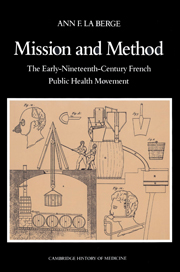Book contents
- Frontmatter
- Contents
- List of tables and illustrations
- Preface
- Acknowledgments
- Introduction
- I Community, method, context
- Chapter 1 Public health and the community of hygienists
- Chapter 2 The methodology of public hygiene
- Chapter 3 The context of public hygiene: National public health policy
- II Carrying out the mission: Institutionalization, investigation, moralization, and practical reform
- III Public health before Pasteur
- Epilogue
- Appendixes
- Bibliographical Note
- Index
Chapter 3 - The context of public hygiene: National public health policy
Published online by Cambridge University Press: 17 September 2009
- Frontmatter
- Contents
- List of tables and illustrations
- Preface
- Acknowledgments
- Introduction
- I Community, method, context
- Chapter 1 Public health and the community of hygienists
- Chapter 2 The methodology of public hygiene
- Chapter 3 The context of public hygiene: National public health policy
- II Carrying out the mission: Institutionalization, investigation, moralization, and practical reform
- III Public health before Pasteur
- Epilogue
- Appendixes
- Bibliographical Note
- Index
Summary
The public health movement developed within the context of Restoration initiatives, policies, and institutions that reflected and built upon traditional public health concerns – epidemic prevention and control – as well as the public health idea inherited from the Enlightenment and Revolutionary eras. Hygienists believed that the scope of public health was all-encompassing; nothing was unrelated to the preservation of health. The Restoration government, however, took a more focused view, concentrating on a few specific problems and working through a limited number of institutions. Public health institutions and policies emanating from the Restoration government included the Royal Academy of Medicine, which advised the government on public health matters and helped shape national public health policy; the sanitary administration, created by the 1822 sanitary law, whose purpose was to prevent the importation of contagious epidemic diseases; and national health care policies and programs including officiers de santé and the médecins des épidémies, and the national vaccination program with its depositories (dépôts de vaccine) and committees.
THE ROYAL ACADEMY OF MEDICINE AND PUBLIC HEALTH
The Royal Academy of Medicine continued the policies and programs of the Royal Society of Medicine, advising the government on major public health questions. The Royal Society of Medicine was founded in 1776 as a governmental commission to deal with the problems of epidemics and epizootics, and during the late 1770s and 1780s it acted as a national clearinghouse, receiving information from its provincial correspondents and intendants and dispatching members to give assistance to areas invaded by epidemics.
- Type
- Chapter
- Information
- Mission and MethodThe Early Nineteenth-Century French Public Health Movement, pp. 82 - 110Publisher: Cambridge University PressPrint publication year: 1992

